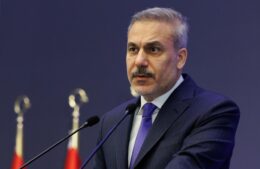An Islamized Armenian Family in Marzovan: A Story of Courage and Sacrifice
- (0)
\n
An Islamized Armenian Family in Marzovan: A Story of Courage and Sacrifice –
\n
By Florence Avakian
\n
It was a few months after the start of the Armenian Genocide in 1915. Tsolag Dildilian and his family converted to Islam in order to remain in their town of Marzovan. Outside their home, they assumed a Turkish identity; but at home they lived as Armenian Christians.
\n
With this posture, they were also able to hide and save a large number of Armenians during the Genocide.
\n
The mystery of this extraordinary family was related by Dr. Armen Marsoobian, chairman of the Philosophy Department at Southern Connecticut State University, during a lecture on Thursday evening, May 29. He was introduced by the Very Rev. Fr. Daniel Findikyan, director of the Krikor and Clara Zohrab Information Center of the Diocese of the Armenian Church of America (Eastern), which sponsored the lecture.
\n
Dr. Marsoobian whose parents were Genocide survivors, opened his revealing talk by noting that he had grown up in a home where the story of this colossal tragedy was related as “black and white: Turks were the perpetrators and Armenians the victims.”
\n
But his family’s story was different. His maternal grandfather Tsolag, a professional photographer needed by the Ottoman military, was spared, and he could thus save his immediate family in Marzovan. But other relatives in Sivas, Amasya, Samsun, Vezirkopru and Trabzon all perished. Following the end of World War I, due to Mustafa Kemal’s nationalists, his family was forced to leave Turkey, settling first in Greece, then America.
\n
The story took a strange turn when Prof. Marsoobian learned that his grandfather had emigrated to America before World War I, but the latter’s wife and children remained behind near Palu, surviving due to the protection of an Islamized uncle who had converted so he could be released from prison. Eventually, his grandmother and father came to America.
\n
Mysterious Islamized Armenian
\n
Who was this relative who had saved Dr. Marsoobian’s father from certain death?
\n
Showing rare photographs and written records he had acquired, Dr. Marsoobian explained that his grandfather Tsolag Dildilian and his brother Aram were photographers with studios in Marzovan, Samson, Konya and Amasya.
\n
“I was shocked to learn that their family had converted to Islam on August 10, 1915, and adopted Turkish identities,” revealed Dr. Marsoobian. “This was not a voluntary conversion, for it was done under the coercive pressure of a violent and, in most cases, fatal deportation. Why was this crucial information kept secret from me?”
\n
As he delved deeper into the mystery, he learned that August 10, 1915, was also the day that the Armenian professors, staff and students and their families who had sought sanctuary on the campus of Anatolia College where his grandfather worked as a photographer, were rounded up and marched to their deaths.
\n
The genocidal process in Marzovan began on April 29, 1915, with more than 1,200 Armenian males arrested, jailed and eventually executed in the next two months. One of the detainees, Garabed Kiremidjian, with personal and financial relationships with local government officials, persuaded a Mahir Bey to accept 50 liras from anyone who so desired to convert to Islam to escape deportation to Aleppo. The first mass conversions in Marzovan took place in June and early July, 1915.
\n
Ten Percent
\n
“Ironically, interior minister Taalat Pasha had ordered a halt to most conversions when he realized that too many Armenians were willing to convert to escape death, thus undermining the Committee of Union and Progress’ plan to reduce the number of Armenians to under 10 percent of each province’s population.”
\n
About 3,000 women, elders and children were converted, according to Kiremidjian who also reported that the 10 percent rule was implemented, with 1200 who had paid the bribe allowed to stay, while 1,800 converts were deported. Kiremidjian also reported that “a large number of Protestant Armenians were converted, while most Catholic and Orthodox Armenians refused to do so.
\n
By August, 1915, “the only non-converted Armenians were those in Anatolia College, including my family the Dildilians and the Haroutiounians,” said the speaker. The leaders of Anatolia College “had successfully bribed local officials to protect their Armenian staff and their families. However, on August 10, the gendarmes entered the campus, and deported the Armenians.
\n
Dr. Marsoobian’s grandfather Tsolag was informed that his protection would only continue if he converted. “After much argument within the family and with the encouragement of Kiremidjian, the family converted on the afternoon of August 10, 1915.”
\n
Using a series of rare photographs in his multi-media presentation, Dr. Marsoobian showed the Haroutiunian family of his great aunt Haiganouch (Tsolag’s sister), secretly celebrating Armenian Christmas 1916. Among the five young men, Aram, Tsolag’s younger brother had an amputated leg, Aram, thus exempting him from military service. But the other young males would have been considered deserters, said the lecturer, and would have been subject to immediate arrest and execution.
\n
Flag of Resistance
\n
These four young men had been hidden in the family’s house since summer of 1915. The photo showed a sacramental candlestick, wafer and incense holder on the table, as well as a flag with three horizontal stripes, two oblique bands and three stars in each. “This resembles the flag of theSociety of Armenian Students of Geneva, Geneva being the center of diasporan Armenian nationalist activity in the 1890s.”
\n
Both the Social Democratic Hunchakian Party, and the Armenian Revolutionary Fedration orDashnaktsutiun were active in Geneva, with the former founded by Armenian university students. “This is a statement of resistance—spiritually and in the name of the nascent Armenian nation,” stated Dr. Marsoobian with understandable pride.
\n
Meanwhile, the deportations continued from late June into July 1915. The day of reckoning came as the gendarmes descended on Anatolia College, and all the professors, teachers with their families, as well as students and workers were loaded onto ox carts and driven out.
\n
“The survival of the nation’s cream” motivated the Dildilian family to rescue the few Armenians who avoided or escaped the deportations. These educated young men and women of Anatolia College who were hidden by the family for two years, provided the hope that the nation would be reborn once the war ended,” stated Dr. Marsoobian.
\n
Aram had devised a plan for his three college friends to escape from the deportation caravan, return to his family home, and provision them with supplies, medicine and arms, so they could escape into the mountains. Tragically the mother and sister of one of the young men also on the caravan could not join them, and the parting was heartrending.
\n
Meanwhile, the winter in the mountains is severe, and the young men returned to Haiganouch’s home where Aram enlarged the hiding place making it permanent with two sections with mirrors for a lookout, “so that if one part is found, the back section will be safe. More easily detectable hiding places were made around the property, so that if police searches found these ‘fake’ hiding places empty, they would then assume that no one was hidden in the house.”
\n
Soon six young men were hiding in the house, which increased to ten men, too many and too dangerous to keep in one place. Another eight young women joined them, and with Haiganouch and her five children, a total of 23 were living in the household at one point.
\n
At this time, there were also an unknown number of young people hidden in Tsolag’s house. “Neither Tsolag nor Haiganouch knew the details of each other’s activities in hiding these young people. A mutual ignorance may well have been a safety strategy. The less one knew of each other’s activities, the less the likelihood of a coerced betrayal of each.”
\n
And in the larger picture of one and a half million innocent victims of genocidal horror, this was the story of three courageous siblings, Tsolag, Aram, and Hiaganouch “who risked their lives to save their fellow human beings”-and whose heroism played an important role during this darkest chapter in Armenian history, noted Dr. Marsoobian.
\n


















